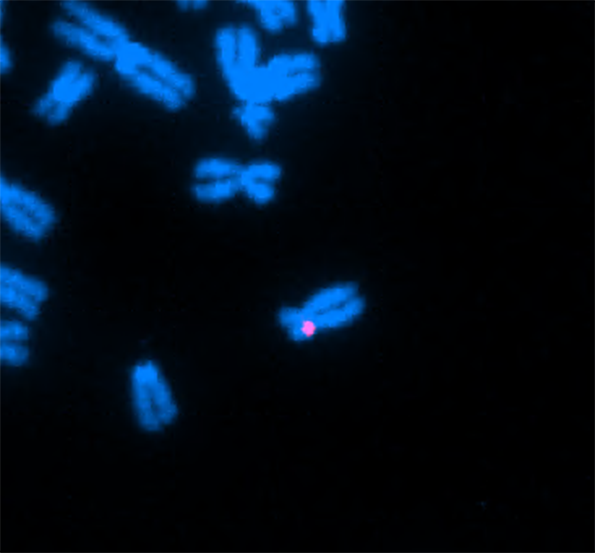Subcentromere dGH in-Site™ Probes
Bioinformatically designed probes for identifying centromeres.

Above Fig.: dGH subCEP labeled in 6-FAM targeting pericentromeric DNA on the p-arm of chromosome 12 in a metaphase spread from a human control cell line.
Single-Stranded Subcentromere dGH Probes for Enumeration and Unique Structural Data.
The dGH method differs from traditional FISH as a result of its unique chromosomal preparation technique. Analog nucleotide incorporation during the DNA replication phase of the cell cycle enables exonuclease daughter strand degradation that leaves dGH prepped chromosomes single-stranded. While the sample preparation differs, methods and equipment used for traditional FISH are also used for dGH. dGH probe signals can be visualized using the same fluorescence microscopes used for FISH imaging, making visualization and analysis as simple as possible.
Single-stranded chromosomes allow for unidirectional dGH probe binding from which strand-orientation data can be generated that traditional FISH assays cannot provide. dGH detects inversions without needing foreknowledge of likely breakpoints and which can be as small as single-digit kilobases, for some probes.
The versatility of the dGH platform enables it to provide value in numerous areas of biomedical research. Probes are designed to provide arm-specific reference signals and can be multiplexed with any other dGH™ probes to create custom data sets.

Above Fig.: dGH subCEP labeled in Atto550 targeting pericentromeric DNA on the p-arm of chromosome 8 in a metaphase spread from a human control cell line.
The Value of Single-Cell Analysis and Bioinformatic Design.
The data which can be produced from many sequencing platforms can indicate when structural rearrangements occur, but the intermediate alignment step injects uncertainty. Also, except where data are being derived in a single-cell fashion, abnormalities are identified based on combined data. Neither is the case with dGH. dGH assays are always based on direct visualization of single cells.
dGH in-Site probes are manufactured using bioinformatically-selected oligonucleotide sequences, meaning no repetitive DNA blocking is required and probes, like the chr8p subCEP seen here can be freely multiplexed. You can design custom assays which employ reference centromeric markers along with any other dGH probe you wish, such as our off-the-shelf gene probes, or custom probes targeting other loci of interest to you.
*For use in metaphase cells fixed with 3:1 MeOH:Acetic acid.

